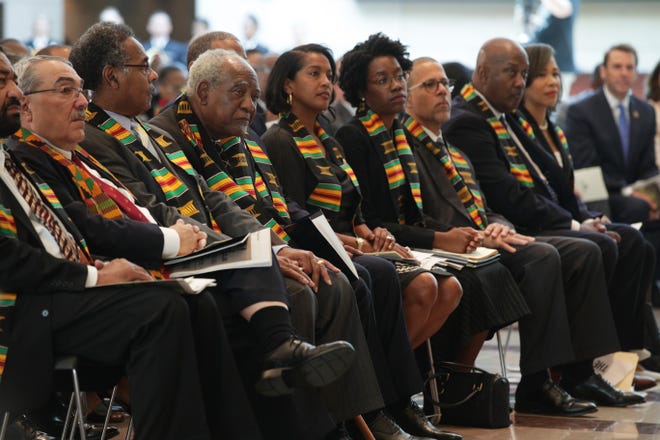Fact check: Yes, Kente cloths were historically worn by empire involved in West African slave trade
Kente, known as nwentoma in Akan, is an indigenous Ghanaian textile, made of interwoven cloth strips of silk and cotton. Kente academic stoles are often used by African Americans as a symbol of ethnic pride.
On June 8, 2020, Democratic members of Congress wearing kente cloths and face masks knelt in Emancipation Hall to memorialize Black lives lost to police brutality. House Speaker Nancy Pelosi, D-Calif., read the names of unarmed Black people who’ve recently been killed by police.
Kente cloth comes from the Asante, or Ashanti, peoples of Ghana and Ewe peoples of Ghana and Togo. A popular legend claims creators of kente cloth presented the cloth to Asantehene Osei Tutu, the Asante kingdom's first leader. Tutu named the cloth “kente,” meaning basket, and adopted the fabric as a royal cloth for special occasions. Tutu, who lived from 1660 to 1712 or 1717, unified several small Asante kingdoms to create the Asante empire. He is credited with expanding the Asante throughout most of Ghana and introducing his subjects to the gold and slave trades along the West African coast.
The Asante supplied British and Dutch traders with slaves in exchange for firearms, which they used to expand their empire. Slaves were often acquired as tributes from smaller states or captured during war. Some slaves were brought across the Atlantic whiles others stayed in Africa to work in gold fields.

Not cultural appropriation.

Cultural appropriation.
Kente, known as nwentoma in Akan, is an indigenous Ghanaian textile, made of interwoven cloth strips of silk and cotton. Kente academic stoles are often used by African Americans as a symbol of ethnic pride.
On June 8, 2020, Democratic members of Congress wearing kente cloths and face masks knelt in Emancipation Hall to memorialize Black lives lost to police brutality. House Speaker Nancy Pelosi, D-Calif., read the names of unarmed Black people who’ve recently been killed by police.
Kente cloth comes from the Asante, or Ashanti, peoples of Ghana and Ewe peoples of Ghana and Togo. A popular legend claims creators of kente cloth presented the cloth to Asantehene Osei Tutu, the Asante kingdom's first leader. Tutu named the cloth “kente,” meaning basket, and adopted the fabric as a royal cloth for special occasions. Tutu, who lived from 1660 to 1712 or 1717, unified several small Asante kingdoms to create the Asante empire. He is credited with expanding the Asante throughout most of Ghana and introducing his subjects to the gold and slave trades along the West African coast.
The Asante supplied British and Dutch traders with slaves in exchange for firearms, which they used to expand their empire. Slaves were often acquired as tributes from smaller states or captured during war. Some slaves were brought across the Atlantic whiles others stayed in Africa to work in gold fields.
Not cultural appropriation.

Cultural appropriation.


